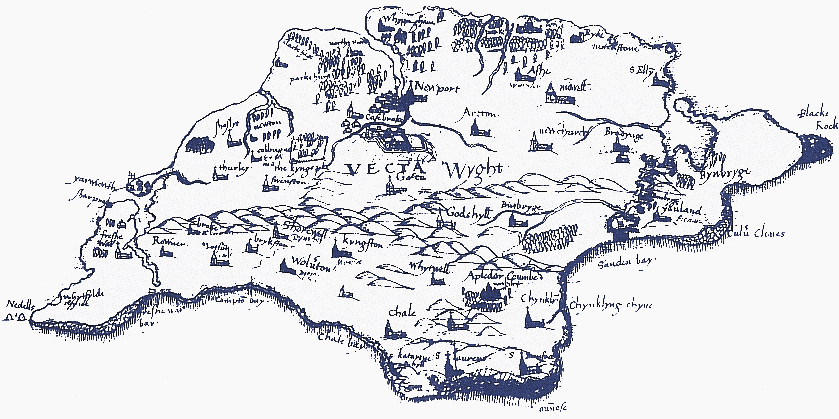

Around 1900 BC the Beaker people arrived - so called from their distinctive pottery. They called the Island Wiht (weight) meaning raised or what rises over the sea. Then the Romans arrived in 43 AD and translated Wiht into the name Vectis from the Latin veho meaning lifting.
The Roman rule started under Vespasian and continued peacefully for over four hundred years. Then followed a period of strife starting with the Saxons under Cerdic and Cynric in 530 AD. Many of the natives were slaughtered and four years after Cerdic's death the government was divided between his two nephews Stuf and Wihtgar. In 544 Wihtgar died and was buried at Carisbrooke. In 661 AD, Wight changed hands again when it was taken by Wulfhure, King of the Mercians, but it was in 686 AD that the West Saxon King, Caedwalla, conquered it and brought Christianity to the Island.
For two centuries the people of Wight then led a fairly peaceful life until the Danes arrived this far south. In 897 AD their visits for 'burning and killing' went on for over 100 years so the Islanders lived in constant fear.
At the time of the Norman Conquest, William the Conqueror granted overlordship of the Isle of Wight to his relative William FitzOsbern who began the construction of a castle at Carisbrooke. The lordship of the Island passed to the De Redvers family in 1101, with the hereditary rights and privileges that accompanied it, until the Countess Isabella De Fortibus, the last survivor in the family, sold the Island to Edward 1 in 1293 for six thousand marks.
The acquisition of full control of the Island by the crown was important because the Island's vulnerability to invasion. The lordship of the Island was now a royal appointment. One of the lords of the Island - Henry Beauchamp, Duke of Warwick - was actually given a title of King to the Isle of Wight in 1444 by Henry V1, who attended the ceremony and placed the crown on his head.
During the Hundred Years' War, the Island, like much of the south coast, became a target for marauding French. The Island's only fortification, the Norman Castle at Carisbrooke, assumed a defence role for which it was unsuited owing to its central position; The French could land on the coast and burn and plunder while ignoring the castle. Towns and villages like Yarmouth, Newtown and Newport were sometimes attacked and burned. It is said that in 1377 a party of French fell into an ambush on the outskirts of Newport and were cut to pieces in Dead Man's Lane, now Trafalgar Road. They are supposed to be buried at 'Noddies Hill', now known as Nodehill or Upper St. James' Street. On the same occasion the French besieged the castle, but, according to the legend, retired on the death of their commander, shot from the castle's west wall. Concern about the French attacks is shown in the frequent modifications made to the Castle's defences in the 14th Century.
The strategic importance of the Island increased with the development of Portsmouth as a permanent naval base. Henry VIII accordingly built additional fortifications on the island at Yarmouth, East & West Cowes and Sandown, sometimes re-using stone from dissolved monasteries as building material. Sir Richard Worsley, Captain of the Island at this time, successfully commanded the resistance to the last of the French attacks in 1545, at the time of the loss of the Mary Rose.
During the reign of Elizabeth 1, the Island was again threatened by invasion, this time from Spain. Sir George Carey, cousin of the Queen and Captain of the Island, took up residence at Carisbrooke Castle in 1583 and undertook repairs to the defences. Although the Armada was defeated in 1588, the Spanish threat remained, and the outer fortifications of Carisbrooke Castle were built between 1597 and 1602 in response to the invasion scare.
At the outset of the Civil War in 1642, the Parliament assumed control of the Island and retained their control throughout the conflict. In spite of this, King Charles 1 went to the Island on escaping from imprisonment at Hampton Court in November 1647. As a prisoner at Carisbrooke Castle, the King made several unsuccessful attempts to escape before being transferred to Newport in September 1648, where abortive negotiations with Parliament (known as the Treaty of Newport) took place. In November, the King was seized by the Army and taken to Hurst Castle and then to his trial and execution in London.
In the nineteenth century the Island was transformed by the coming of the railways. Queen Victoria took advantage of the island's new accessibility by using Osborne as her retreat. Affairs of the state soon followed her and the modestly furnished family home had to be enhanced with apartments where she could receive foreign heads of state. However, her children enjoyed many hours and a great deal of freedom at Osborne as a visit to Swiss Cottage will indicate. Queen Victoria's affection for Osborne added to the Island's attractions of climate and scenery, and Ryde, Sandown, Shanklin & Ventnor expanded from fishing villages to fashionable resorts.
Queen Victoria's youngest daughter, Princess Beatrice, succeeded her husband, Prince Henry of Battenburg as Governor of the Island in 1896, and regularly used Carisbrooke Castle as her summer residence. After her death in 1944 the office was left vacant until, at the request of the Island, a new Governor was appointed in 1957 - the seventh Duke of Wellington. He was succeeded in 1965 by Admiral of the Fleet, the Earl Mountbatten of Burma, a great nephew of Princess Beatrice. When the Island gained full County status under the Local Government Act in 1972, Earl Mountbatten was appointed the Island's first Lord Lieutenant as well. Since his death in Ireland in 1979, the Island has been without a governor.